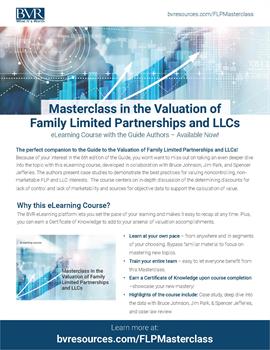Comprehensive Guide for the Valuation of Family Limited Partnerships and LLCs, 6th Edition: Best Practices, Best Data Sources, Best Appraisal Reports
October 2021 Hardcover (300 pages)
Bruce A. Johnson, James R. Park, Spencer Jefferies
Partnership Profiles, Inc.
The Comprehensive Guide for the Valuation of Family Limited Partnerships, published by Partnership Profiles, includes all new updates since the 5th edition released in 2017.
This 300-page book is a step-by-step guide on valuing noncontrolling interests in privately-held FLPs and LLCs using best practices. This Best Practices guide for valuing noncontrolling interests includes the following:
- 5 New Case-Study Valuation Examples
- stocks, bonds and money market investments
- income producing real estate
- non-income producing real estate
- multiple asset types - marketable securities, real estate and promissory notes
- oil/gas mineral interests
- Updated Study on Market Pricing of Liquidating Noncontrolling Real Estate Interests
- Employing the Best Empirical Data in a Valuation and the Best Valuation Method
- Revised and Updated Section on calculating Discounts for Lack of Marketability
- How to Value General Partnership Interests
- How to Handle Multi-Tiered Partnerships (stacked discounts)
The book includes all of PPI's annual Partnership Re-Sale Discount Studies published from 2016-2020. This is a comprehensive update and many of the changes are based on the authors' experience handling IRS audits regarding discounts for lack of control and marketability.
Table of Contents
Preface
About the Authors
I. Overview
II. Disadvantages of the Asset Based Approach
A. Use of Average Discounts in Published Studies
B. Inappropriate Reliance on Case History
III. Selecting Proper Valuation Methodology
A. Income Approach
B. Market Approach
C. Asset Based Approach
IV. Empirical Data for Income Approach
A. Marketable Securities
B. Real Estate
1. Listed Real Estate Investment Trusts (REITs)
2. Publicly Held Limited Partnerships and Nonlisted REITs
C. Other Sources of Real Estate Returns
D. Summary
V. Empirical Data for Market Approach
A. Closed-End Funds
B. Publicly Held Real Estate Entities
1. Comparability of Data
2. Secondary Market
a) Impact of Liquidations
b) Mechanics of Buying and Selling LP Interests
(1) Role of the Seller
(2) Role of the Buyer
(3) How Auctions Are Conducted
(4) Sales Proceeds and Distributions
3. Questions Raised About Secondary Market Transaction Data
C. Liquidating Programs
D. Summary
VI. What Should Be Included in an Appraisal Report
VII. Valuation Examples
A. FLP A – Marketable Securities
1. Income Approach – FLP A
a) Determination of Discount Rate
b) Scenario 1 - Discounted Net Cash Flow Forecast
c) Scenario 2 - Reinvestment of Capital Appreciation
d) Scenario 3 - Capitalization of Net Cash Flow
2. Market Approach - FLP A
a) Selection of Closed-End Funds
b) Application of Price to NAV Ratios
3. Reconciliation of Values - FLP A
B. FLP B – Income Producing Real Estate
1. Income Approach – FLP B
a) Determination of Discount Rate
(1) Build Up Method - REITs
(2) Build Up Method – Real Estate Limited Partnership Returns
(3) Discount Rate Computations
b) Net Cash Flow Forecast
(1) Scenario 1 – Five Year Liquidation Horizon
(2) Scenario 2 – Ten Year Liquidation Horizon
2. Market Approach – FLP B
a) Sources of Data
(1) Minority Interest Discount Database™
(2) Partnership Guideline Reports™
b) Application of Price to NAV Ratio – Real Estate
3. Reconciliation of Values for FLP B
C. FLP C – Nonincome Producing Real Estate
1. Income Approach – FLP C
a) Determination of Discount Rate
b) Net Cash Flow Forecast
(1) Scenario 1 – Five Year Liquidation Horizon
(2) Scenario 2 – Ten Year Liquidation Horizon
2. Market Approach – FLP C
a) Selection of Guideline Entities
(1) Undeveloped Real Estate Entities (Group 1)
(2) Nondistributing Real Estate Entities (Group 2)
b) Selection of Price to NAV Ratio
3. Reconciliation of Values for FLP C
D. FLP D – Mix of Assets
1. Income Approach – FLP D
a) Determination of Discount Rate
b) Net Cash Flow Projection
(1) Scenario 1
(2) Scenario 2
(3) Reconciliation of Scenarios 1 and 2
2. Market Approach - FLP D
a) Selection of Comparable Entities
(1) Closed-End Funds
(2) Publicly Held Real Estate Interests
b) Application of Price to NAV Ratios
3. Reconciliation of Values for FLP D
E. FLP E – Oil & Gas Interests
1. Income Approach – FLP E
a) Determination of Discount Rate
b) Net Cash Flow Projection
2. Market Approach – FLP E
a) Selection of Oil and Gas Partnerships
b) Application of Price to NAV Ratios
3. Reconciliation of Values for FLP E
VIII. Unique Appraisal Assignments
A. Family Limited Partnerships with Nonmarketable Securities
B. Valuing General Partnership Interests
C. Valuing Assignee Limited Partnership Interests
D. Valuing Multiple or Tiered Limited Partnerships
E. Valuing Family Limited Partnerships with Promissory Notes
IX. Discount for Lack of Marketability
A. Discounts Observed in Publicly Held Limited Partnerships
B. Use of Average or Fixed Discounts
C. Empirical Approach for Determining DLOM
1. Study A – Private Equity vs. Public Equity Returns
2. Study B – Restricted Stock Returns
3. Study C – Long-Term vs. Short-Term Bonds
4. Conclusion
D. Examples
1. FLP A - Marketable Securities
2. FLP B – Income Producing Real Estate
3. FLP C – Nonincome Producing Real Estate
4. FLP D – Mixed Assets
5. FLP E – Oil and Gas Interests
E. Conclusion on Lack of Marketability
X. Summary
XI. Conclusion
XII. Appendix – Secondary Market Pricing of Liquidating Noncontrolling Interests
XIII. Partnership Profiles Executive Summary Reports – 2016 through 2020
.png?sfvrsn=88e5c0b2_2)
